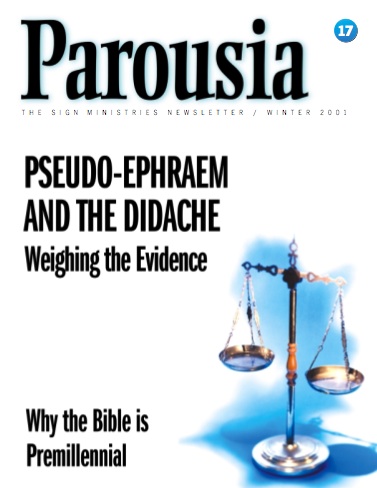I don’t know what position Tom Schreiner holds on the rapture. My guess is that he is post-trib, but I could be mistaken. And I do not know if he has actually considered the Prewrath position.
I want to qualify a couple of statements he makes:
He states in this sermon that the timing of the rapture is not clear in Scripture. Of course, we would disagree with him since we believe that the Bible is very clear that the Church will encounter the Antichrist’s Great Tribulation and will then be raptured followed by the Day of the Lord’s wrath upon the ungodly of this world.
One other element that I would disagree with him on is that he believes that when Satan is thrown to the earth with wrath in Revelation 12 Schreiner thinks that happened at Christ’s First Coming at the cross. I believe that it happens at the midpoint of the seven year period when Michael the Restrainer is removed and the Great Tribulation begins. Also, unfortunately, he spiritualizes the mark of the beast. But historical premillenialists tend to be inconsistent in certain areas such as this. You just have to filter the good from the bad.
Nevertheless, Schreiner does an excellent job in exegeting Revelation 20.
Here is the audio sermon.
Postmillennialism
Biblical Calenders, 2 Thessalonians 2, and Danites

This is a session from the 2009 2nd Annual Prewrath Conference in Eau Claire, Wisconsin. Charles Cooper explicates Biblical Ancient Calenders such as the Egyptian, Jewish, and Western calenders as it pertains to prophetic chronology. He also expounds on 2 Thessalonians 2, as well as Danites returning to Israel recently!
Download as MP3
The Teaching of the Early Church On the Second Coming of Christ
Guest Article by Gary Vaterlaus
Many claims have been made by pretribulationists that the early Church believed that Christ would come before the events of the 70th Week of Daniel begin–that is, before the period of tribulation. Dwight D. Pentecost in his book Things to Come uses selected quotes from some of the early church fathers to try to show that they believed in the imminent return of Christ (see pp. 168-169).
More recently, Grant R. Jeffrey in his book Apocalypse: The Coming Judgement of the Nations devotes the entire Appendix to references to early church writings, some which he claims show that they held to an “any moment,” imminent coming of the Lord.
I believe that we should let the Church fathers speak for themselves. Below are lengthy quotes from 12 documents of the early Church fathers from the first four centuries showing that they believed that the Church would be present on the earth during the Great Tribulation of Antichrist. From my review of the early Church writings I would agree with Robert Gundry’s assessment that “…the early Church did not hold to the doctrine of imminence. The very passages cited for imminence (by the pretribulationists) reveal a belief that the Church will pass through the tribulation.” (Robert Gundry, The Church and the Tribulation, p. 179). In fact, in this same book Gundry shows convincingly that the pretribulation theory of the rapture was not known nor widely held until the mid-nineteenth century (see pp. 185-188).
Our sole rule for faith and practice must be Scripture. The teachings of the early Church do not “prove” that pretribulationism is incorrect, only Scripture can do that (and it does). However, as Robert Gundry sates, “…the antiquity of a view weighs in its favor, especially when that antiquity reaches back to the apostolic age. For those who received their doctrine first-hand from the apostles and from those who heard them stood in a better position to judge what was apostolic doctrine than we who are many centuries removed” (The Church and the Tribulation, p. 172).
The prewrath rapture position has its roots in historical premillennialism–the belief that the Church will be persecuted by the Antichrist, delivered at Christ’s coming, and then God’s wrath will be poured out on the wicked who remain, followed by the establishment of Christ’s earthly kingdom. As you can see from the quotes below, this is precisely what the early Church fathers wrote. I quote many of them at length so that the claim of ignoring context cannot be made. I have emphasized the relevant portions.
What Did the Early Church Fathers Teach on the Timing of the Second Coming?

This presentation on what the early church taught was given last October in O’Fallon Missouri at an eschatology forum. There are three speakers who had twenty minutes each to give their case: Steve Gregg (Preterist), Charles Cooper (Prewrath), Thomas Ice (Pretribulational).
I have included Steve Gregg’s presentation because I want you to hear what a preterist case sounds like. It goes something like this:
“Ok, I grudgingly admit that preterism was never taught in the first three hundred years by a Church Father. But who knows!…maybe one day someone may stumble upon in the sands of Egypt an early Church document with preterist teachings, so therefore we can never be too sure what the early Church taught on this subject.”
What Gregg also does is he invokes sparse preterist writings from the Church Fathers from AD 300-700 to cast doubt on what the early Church taught, as if they have the same weight as futurist writings from the first and second generations of the Church!
In the second presentation, Cooper demonstrates that the early Church clearly taught that the Church would encounter the Antichrist’s Great Tribulation. Cooper even cites in support the authoritative church historian Larry V. Crutchfield, who, himself is a pretribulationalist!
In the third presentation, Ice focuses on the premillennial issue. Prewrath is premillennial as well so we can agree with Ice’s points on that issue.
However, Ice makes a false claim by asserting that the early Church Fathers believed in imminency. They certainly did not believe in imminency in the pretribulational sense that the Church would be raptured before the Antichrist’s Great Tribulation. And some believed that the Church would be raptured soon because they thought that they were in the midst of the Great Tribulation! So Ice’s statements are misleading and incorrect.
The only early citation that Ice attempts to produce is a statement from The Shepherd of Hermas, in which he reads his pretribulational system into this ancient document. He (selectively) cites a statement from Vision 4 that says that if someone has enough faith they can escape a great tribulation. What Ice does is anachronistically reads “escape” as a rapture. But there is nothing in the text that suggests a rapture. In fact, the “escape” in that context indicates a physical escape leaving the person on earth (see Vision 4:2). Nor does Hermas place the Return of Christ before the Great Tribulation. Further, Hermas actually makes statements of enduring the Great Tribulation:
“Blessed are those of you who patiently endure the coming great tribulation and who will not deny their life.” (Vision 2:2)
“Therefore those who endure and pass through the flames will be purified by them…The white part is the age to come, in which God’s elect will live because those chosen by God for eternal life will be spotless and pure…You have also the foreshadowing of the great tribulation that is coming” (Vision 4:3)
It should also be mentioned that like so many of the other early Church Fathers’ exposition of Scripture, this document instead is not didactic intending to interpret what the Bible teaches on the Second Coming — it is part of a vision. The fact that this is the only citation that Ice can produce within the first four hundred years of Church History is very telling.
Ice also invokes a later Church document called Pseudo-Ephraem and purports that there are pretrib statements. This has been thoroughly refuted in this Parousia Newsletter.
In summary, the term “Prewrath” is new, but its essential teaching goes back to the early Church writers, contra preterism, pretribulationism, and amillennialism.
Download as MP3

